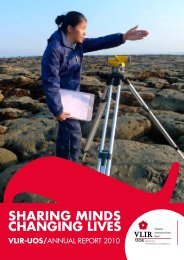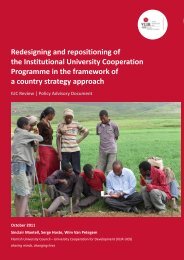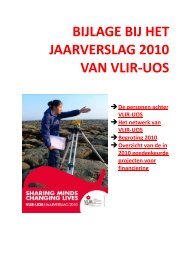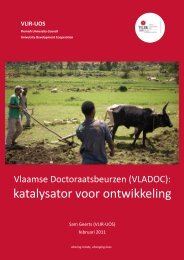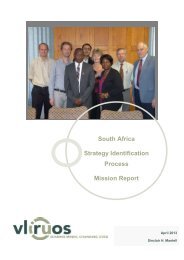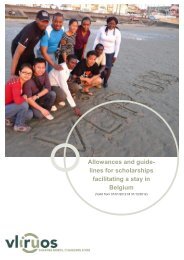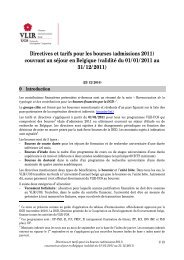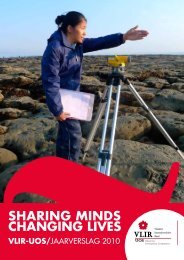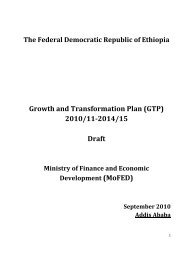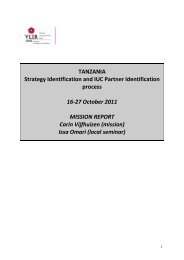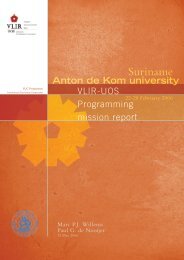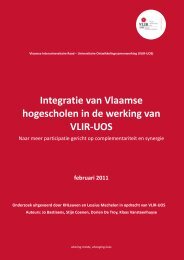Education Sector Development Program - VLIR-UOS
Education Sector Development Program - VLIR-UOS
Education Sector Development Program - VLIR-UOS
Create successful ePaper yourself
Turn your PDF publications into a flip-book with our unique Google optimized e-Paper software.
<strong>Education</strong> <strong>Sector</strong> <strong>Development</strong> <strong>Program</strong> IV<br />
Create forums for increasing awareness about the<br />
importance of having female administrators<br />
Component 6 A gender sensitive curriculum<br />
established and materials produced<br />
Number of forums organized<br />
Number of male and female participants<br />
All teachers will use gender sensitive<br />
curriculum.<br />
Eliminate stereotyping in curriculum and textbooks<br />
Produce and distribute gender sensitive training<br />
materials<br />
Curriculum and textbooks fully revised to<br />
eliminate stereotyping<br />
Number of training materials produced<br />
% of teachers with access to training materials<br />
Special Needs <strong>Education</strong> (SNE)/<br />
Inclusive <strong>Education</strong><br />
1. Situation analysis<br />
The Ministry has<br />
designed a strategy for<br />
Special Needs <strong>Education</strong>,<br />
the final goal of which<br />
is to ensure access and<br />
quality education for<br />
marginalized children and<br />
students with special<br />
educational needs.<br />
Special needs education is the education of<br />
students with special needs in a way that<br />
addresses the students’ individual differences<br />
and needs. Ideally, this process involves<br />
the individually planned and systematically<br />
monitored arrangement of teaching<br />
procedures, adapted equipment and<br />
materials. Inclusive education is a process<br />
of addressing and responding to the diversity<br />
of needs of all learners through increasing<br />
participation and reducing exclusion within<br />
and from education. It involves changes<br />
and modifications in content, approaches,<br />
structure and strategies to respond to<br />
diversity needs. Generally, SNE focuses on<br />
providing services for individual child, while<br />
inclusive education focuses on the change of<br />
the whole system of the school environment to<br />
the need of the individual child.<br />
A limited understanding of the concept of<br />
disability, negative attitude towards persons with<br />
disabilities and a hardened resistance to change<br />
are the major barriers impeding special needs<br />
and inclusive education. The main barriers to<br />
learning are lack of knowledge about diversity,<br />
rigid and poor teaching methods, inconvenient<br />
learning environment, lack of identification<br />
processes, and inadequate assessment<br />
procedures.<br />
The Ministry of <strong>Education</strong> started collecting<br />
data on children with disabilities since 1999.<br />
These indicate that the number of children with<br />
disabilities enrolled in the different levels of<br />
education (mostly in special schools or special<br />
classes in regular schools) has modestly<br />
increased during the last three years, but remains<br />
extremely limited. Applying the international<br />
estimates by WHO of an average 10% prevalence<br />
of disability in any population, in Ethiopia less than<br />
3% of them have access to primary education.<br />
Access to schooling decreases rapidly as children<br />
move up the education ladder and girls are<br />
manifestly underrepresented. Generally schools<br />
have difficulty in addressing their students’<br />
special educational needs. Some studies have<br />
shown that these special schools and special<br />
classes are understaffed, under resourced and<br />
also have a shortage of instructional materials.<br />
The first two <strong>Education</strong> <strong>Sector</strong> <strong>Development</strong><br />
<strong>Program</strong>s did not pay much attention to<br />
the education of children with disabilities.<br />
This changed with ESDP III which gave due<br />
consideration to the expansion of educational<br />
opportunities for children with special educational<br />
needs in order to achieve the EFA goals.<br />
To reduce the existing gap and to actualize<br />
<strong>Education</strong> for All, the Ministry of <strong>Education</strong> has<br />
designed a strategy for Special Needs <strong>Education</strong>,<br />
the final goal of which is to ensure access and<br />
quality education for marginalized children and<br />
students with special educational needs. Different<br />
universities and colleges have started new<br />
teacher education programs on special needs<br />
education. Core curricula have been modified for<br />
children with disabilities and manuals are being<br />
prepared on disability specific curriculum at the<br />
federal level. In addition, special needs education<br />
is mainstreamed across all teacher education<br />
and training institutions in the country. Currently<br />
five Teacher <strong>Education</strong> Institutes and four Higher<br />
<strong>Education</strong> Institutions opened SNE departments<br />
and are training SNE professionals at different<br />
76



